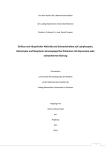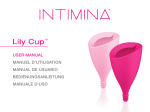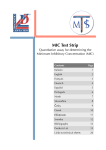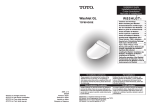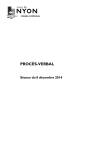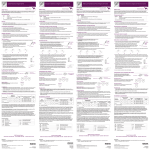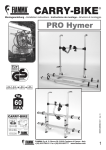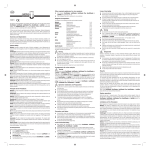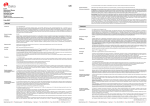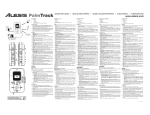Transcript
2. In der Pufferflasche befindet sich bewusst wenig Flüssigkeit. D Chlamydien Schnelltest für die Eigenanwendung zu Hause SCHACHTELINHALT Probebehälter mit Puffer, Abstrichtupfer, Folienverpackung mit Testkassette und Trockenmittel, Gebrauchsanweisung Zusätzlich benötigen Sie eine Uhr. Testkassette Abstrichtupfer PufferÀasche 3. Tauchen Sie den Abstrichtupfer mit der Probe bis zum Flaschenboden ein. Drehen Sie den Abstrichtupfer in der Flüssigkeit und drücken Sie ihn mehrfach an der Seitenwand aus, damit sich Ihr Probenmaterial gut in der Pufferlösung verteilt. 4. Warten Sie 5 Minuten. Sie verfälschen das Ergebnis, wenn Sie länger oder kürzer warten. Während dieser Wartezeit bleibt der Abstrichtupfer in der Flasche. Ergebnisfeld Probefeld S WICHTIGE HINWEISE • Bitte lesen Sie ausführlich die Gebrauchsanweisung bevor Sie den Test anwenden. • Nicht nach dem auf dem Aluminiumtütchen angegebenen Verfallsdatum verwenden. • An einem trockenen Ort zwischen 4°C…28°C aufbewahren. • Nicht verwenden, wenn das Tütchen offen oder beschädigt ist. • Von Kindern fernhalten, nur zur äußeren Anwendung. • Nur für den In-vitro Gebrauch • Das Aluminiumtütchen nur vor der Durchführung des Tests öffnen. • Puffer ist vor dem Mischen korrosiv. • Test, Pufferflaschen und Abstrichtupfer nur einmal verwenden. • Dieser Test ist zur Probennahme vom Gebärmutterhals, also ausschließlich zur Anwendung durch Frauen geeignet. Im Falle einer Infektion wird empfohlen, dass sich auch der männliche (Sexual-)Partner einem Test und einer Behandlung unterzieht. • Waschen Sie sich zur Sicherheit nach der Testdurchführung die Hände. • Dieser Test ist nicht für die Anwendung durch schwangere Frauen geeignet! • Diesen Test nicht während und bis 3 Tage nach der Periode oder während eines Harnwegsinfekts durchführen! • Verwenden Sie ausschließlich den beigelegten Abstrichtupfer und achten Sie vor dessen Anwendung darauf, dass die Originalverpackung unbeschädigt ist! • Treffen Sie keine medizinisch wichtigen Entscheidungen ohne Ihren Arzt! • Sie können die Testbestandteile nach der Durchführung im Hausmüll entsorgen. • Bei den eingesetzten Testmaterialien tierischen Ursprungs (z.B. Antikörper) handelt es sich um potentiell infektiöse Materialien, von denen jedoch keine Gefahr ausgeht, wenn Sie alle Testbestandteile gemäß der Gebrauchsanweisung verwenden. INFORMATIONEN Dieser Test dient zum Nachweis von Chlamydia trachomatis, einer der drei bekannten Spezies aus der Familie der Chlamydien-Bakterien. Infektionen mit Chlamydia trachomatis sind die häu¿gsten sexuell übertragenen Infektionen. Allein für Deutschland wird die Zahl der Neuinfektionen auf 300.000 bis 500.000 pro Jahr geschätzt. Jüngere Erwachsene (15-25 Jahre), Personen mit häu¿g wechselndem Geschlechtspartner, Sexualpartner (auch unbemerkt und symptomlos) in¿zierter Personen sowie Neugeborene in¿zierter Mütter sind am häu¿gsten betroffen. Infektionen ohne Sexualkontakt (z.B. im Schwimmbad) sind selten, aber nicht auszuschließen. Chlamydia trachomatis-Infektionen verursachen häu¿g keine Symptome. Chlamydia trachomatis kann jedoch auch zu Beschwerden wie Augenentzündungen, Arthritis und Entzündungen des Harntraktes führen. Weiteres führen unbehandelte Infektionen häu¿g zu Unfruchtbarkeit und erhöhen das Risiko von Eileiterschwangerschaften und Frühgeburten. In den Entwicklungsländern sind Infektionen mit Chlamydia trachomatis die häu¿gste Ursache für das Erblinden von Neugeborenen. Besonders wichtig ist eine Behandlung von Chlamydien-Infektionen in der Schwangerschaft. Rund 50 % der in¿zierten Mütter geben die Infektion an das Neugeborene weiter. Häu¿ge Komplikationen beim Neugeborenen sind Bindehautentzündungen und Lungenentzündung. Dieser Test erzielte bei der klinischen Leistungsbewertung mit 596 Teilnehmern im Vergleich zur PCR- Methode eine diagnostische Sensitivität von 85,7% und eine diagnostische Spezi¿tät von 98,3%. Es wurde auch eine Laienstudie mit 56 Probandinnen durchgeführt. Von den 56 Probandinnen haben 54 das Resultat richtig interpretiert. PROBENAHME MIT ABSTRICHTUPFER Vor der Probenahme sollten Sie mind. 1 Stunde nicht urinieren, da sonst das Ergebnis verfälscht werden kann. Führen Sie den Test in einer ruhigen Umgebung durch. Nehmen Sie den Abstrichtupfer aus der Verpackung. Falls die Verpackung beschädigt ist, verwenden Sie bitte den Abstrichtupfer nicht, sondern wenden Sie sich an den Hersteller. Die Folienverpackung legen Sie bitte vorerst UNGEÖFFNET beiseite, diese wird erst später gebraucht. 1. Suchen Sie eine bequeme Position wie beim Einführen von Tampons. Führen Sie den Abstrichtupfer vorsichtig bis zum Gebärmutterhals (Ende des Vaginalkanals) ein. Drehen Sie den Abstrichtupfer gleichmäßig für ca. 30 Sekunden und ziehen Sie den Tupfer langsam heraus. 6. Geben Sie nun wie abgebildet 2 Tropfen Probe auf das Probefeld „S“ der Testkassette. Bitte stellen Sie sicher, dass keine Flüssigkeit direkt auf das Reaktionsfeld kommt. 7. Warten Sie nun 15 Minuten. Wenn Sie länger als 20 Minuten warten kann das Ergebnis nicht zuverlässig interpretiert werden. ERGEBNIS ABLESEN UND INTERPRETIEREN POSITIV wird die Probe gewertet, wenn innerhalb der Reaktionszeit von 15 Minuten in der Reaktionszone der Kassette zwei violette Farblinien (bei „C“ und „T“) auftreten, auch wenn die Farblinie bei „T“ sehr schwach ist. Ein positives Ergebnis kann oft auch schon vor vollständigem Ablauf der 15-minütigen Reaktionszeit bestimmt werden. NEGATIV wird das Ergebnis gewertet, wenn nur eine violette Farblinie bei „C“ auftritt. Ein negatives Ergebnis kann erst nach vollständigem Ablauf der 15-minütigen Reaktionszeit mit Sicherheit bestimmt werden. UNGÜLTIG ist das Ergebnis, wenn keine violette Farblinie, bzw. nur eine Linie bei „T“ auf dem Testfeld erscheint, oder das gesamte Testfeld gleichmäßig violett gefärbt ist. Mögliche Gründe für ein ungültiges Ergebnis könnten eine beschädigte Folien- oder Abstrichtupfer-Verpackung, falsche Lagerung oder ein Anwendungsfehler sein. Bitte heben Sie in diesem Fall alle Testmaterialien auf und wenden Sie sich an den Hersteller. Nach mehr als 20 Minuten kann das Testergebnis nicht mehr zuverlässig ausgewertet werden. Entsorgen Sie daher bitte die Testkassette, nachdem Sie das Ergebnis zeitgerecht interpretiert haben. FRAGEN UND ANTWORTEN Was muss ich bei einem positiven Testergebnis tun? Suchen Sie bitte Ihren Arzt auf um mit ihm das Ergebnis zu besprechen. Nehmen Sie zu Ihrem Arztbesuch bitte die vorliegende Gebrauchsanweisung mit, damit sich Ihr Arzt ein genaueres Bild machen kann, welchen Test Sie durchgeführt haben. Was muss ich bei einem negativen Testergebnis tun? Ein negatives Testergebnis schließt eine Infektion von Chlamydia trachomatis mit höchster Wahrscheinlichkeit aus, dennoch wird empfohlen, sich in regelmäßigen Zeitabständen von einem Arzt untersuchen zu lassen. 4. Wait 5 minutes. Test rapide Chlamydia pour l’utilisation individuelle à domicile KIT CONTENTS sample bottle with buffer, swab, foil pack with test cassette and desiccant, instructions for use Please also have a watch or clock to hand. If you wait too long, or not long enough, this will distort the test result. During the waiting time, the swab must remain in the bottle. CONTENU DE LA BOÎTE Gobelet à échantillon avec réactif, écouvillon, ¿lm d’emballage avec cassette de test et siccatif, mode d’emploi. De plus, vous avez besoin d’un chronomètre. Bitte beiliegende Gebrauchsanleitung sorgfältig beachten test cassette swab sample bottle with buffer Anzahl der Tests je Packung Nach Verfallsdatum nicht mehr verwenden darf nicht wiederverwendet werden ist zwischen 4 °C und 28 °C aufzubewahren Chargenbezeichnung korrosiv Geratherm Medical AG Fahrenheitstraße 1 98716 Geschwenda Deutschland 5. Close sample bottle and shake it gently one more time. Hold the sample bottle with the cap upwards, and snap off the tip of the cap. Ecouvillon 3. Immergez l’écouvillon avec l’échantillon jusqu’au fond du flacon. Faîtes tourner l’écouvillon dans le liquide en le pressant plusieurs fois contre la paroi interne pour que la substance échantillon soit bien répartie dans la solution de réactif. 4. Patientez 5 minutes. En attendant moins longtemps ou davantage, vous risquez de fausser le résultat. Tout au long de l’attente, l’écouvillon reste dans le flacon. 5. Refermez le flacon à réactif et l’agiter encore un peu. Tenir le flacon avec le capuchon en haut et briser la pointe en la fléchissant. Champ de résultat IMPORTANT NOTE • Please follow the instructions for use! • Do not use after expiry date. • Store test components between 4° and 28°C. • Do not take the test cassette apart. • For external use only • Keep the test out of reach of children. • In-vitro diagnostic device for personal use. • Open the foil pouch just before running the test. • Buffer is corrosive before mixing. • Use test, buffer-solution bottle and swab only once. • This test is suitable for taking cell samples from the neck of the uterus, and is thus only for use by women. In the event of infection, it is recommended that your sexual partner also takes a test and undergoes treatment. • As a precaution, please wash your hands after performing the test. • This test is not suitable for use during pregnancy! • Do not use this test during menstruation and for three days after the end of your period, or if you have a urinary-tract infection! • Only use the swab provided, and before use, make sure the packaging is undamaged! • Do not make any important medical decisions without consulting your doctor! • After use, the test components may be discarded with your ordinary household waste. • Those parts of the test materials which are of animal origin (e.g. antibodies) are potentially infectious substances, but do not comprise any risk provided all test components are used according to the instructions. INFORMATIONEN This test serves to detect Chlamydia trachomatis, one of the three known types of Chlamydia. Chlamydia infection is the most frequently occurring sexually-transmitted disease. In Germany alone, the number of new infections is estimated at between 300,000 and 500,000 per year. Younger adults (between age 15 and 25), those who frequently change sexual partners, the sexual partners of those infected (even those without symptoms who are unaware that they carry the infection), as well as newborn babies of infected mothers, are the most frequently affected. Infections without sexual contact (e.g. from swimming pools) are rare, but not impossible. Chlamydia trachomatis infections frequently have no symptoms. However, they may also lead to complaints such as eye infections, arthritis, and urinary-tract infections. In addition, untreated infection frequently leads to infertility, as well as increasing the risk of ectopic pregnancy and preterm births. In developing countries, Chlamydia trachomatis infection is the most common cause of blindness among newborns. It is particularly important to treat Chlamydia infections in pregnancy. Around 50% of infected mothers pass the infection on to their newborns. Common complications among newborns include conjunctivitis and pneumonia. TAKING A SAMPLE USING THE SWAB Before taking a sample, avoid urinating for at least one hour, since otherwise an incorrect result may be yielded. Perform the test in a location where you will be undisturbed. Take the swab out of the pack. If the packaging is damaged, please do not use the swab and instead contact the manufacturer. 1. Select a comfortable position, such as one you would adopt for inserting a tampon. Carefully insert the swab into your vagina as far as the neck of the womb (top end of your vagina). Rotate the swab evenly for about 30 seconds and then slowly withdraw the swab. 7. Now wait 15 minutes. If you wait for longer than 20 minutes, it will no longer be possible to interpret the result reliably. READING AND INTERPRETING THE RESULT A sample is considered positive if, within the reaction time of 15 minutes, two purple lines appear in the reaction zone of the cassette (at „C“ and „T“), even if the coloured line at „T“ is very faint. A positive result can often be identi¿ed before the end of the 15-minute reaction time. A result is considered negative if there is only one purple line at „C“. A negative result can only be established with certainty at the very end of the 15-minute reaction time. A result is considered invalid if no purple line appears or there is only a line at „T“ in the test ¿eld, or the entire test ¿eld turns purple. Possible reasons for an invalid result may be a damaged foil or swab pack, incorrect storage, or an error in performing the test. Please retain all the test materials and contact the manufacturer. If you wait more than 20 minutes, it will no longer be possible to evaluate the test reliably. Please therefore dispose of the test cassette once you have ¿nished interpreting the result at the correct time. QUESTIONS AND ANSWERS What should I do if my test result is positive? Please see your doctor in order to discuss the result. Please take these instructions for use with you to your appointment, so that your doctor is able to gain a clearer picture of the test you have performed. What should I do if my test result is negative? A negative test result means that you are highly unlikely to have a Chlamydia trachomatis infection, but it is still recommended that you are regularly checked by your doctor. SYMBOLS Attention, see instructions for use Test per kit Manufacturer For in vitro diagnostic use only Use by Do not reuse Store between 4 °C and 28 °C Lot number corrosive Geratherm Medical AG Fahrenheitstraße 1 98716 Geschwenda Germany Swab STERILE : Puritan Medical Products Co. 31 School Street, Guilford, USA 2. La bottiglietta con soluzione buffer contiene appositamente una ridotta quantità di liquido. I 3. Immergere il tampone cervicale contenente il campione fino al fondo della bottiglietta. Ruotare il tampone cervicale all’interno del liquido e premerlo più volte contro le pareti della bottiglietta in modo che il materiale campione si distribuisca perfettamente nella soluzione buffer. Test rapido Clamidia per l’auto diagnosi CONTENUTO DEL KIT bottiglietta contenitore per il campione con soluzione buffer, tampone cervicale, involucro in plastica contenente card e essiccante, istruzioni per l‘uso Si prega di tenere inoltre a disposizione un orologio. cassetta test L’EXECUTION DU TEST Veuillez maintenant préparer le ¿lm d’emballage. Dans 15 minutes, vous allez savoir s’il y a une infection à chlamydia trachomatis. Champ échantillon S 6. Now, as shown in the illustration, place 2 drops of the solution onto the sample field „S“ on the test cassette. Please make sure that no liquid falls directly onto the reaction field. 2. There is purposely only a small quantity of solution in the sample bottle. Abstrichtupfer STERILE : Puritan Medical Products Co. 31 School Street, Guilford, USA Cassette de test Flacon à réactif sample ¿eld S Hersteller nur für die In-vitro Verwendung PERFORMING THE TEST You should now prepare the foil pack. In just 15 minutes, you will learn whether or not you have a Chlamydia trachomatis infection. result ¿eld Compared with the PCR method, in a clinical performance evaluation with 596 participants, this test achieved diagnostic sensitivity of 85.7% and diagnostic speci¿city of 98.3%. A lay study was also conducted with 56 subjects. Of these 56, 54 interpreted the result correctly. SYMBOLINDEX 2. C’est tout à fait intentionnellement que le flacon à réactif contient peu de liquide. F Chlamydia rapid test for self testing DIE TESTDURCHFÜHRUNG Bitte bereiten Sie nun die Folienverpackung vor. In nur 15 Minuten erfahren Sie, ob eine Infektion mit Chlamydia trachomatis vorliegt. 5. Die Pufferflasche verschließen und noch einmal etwas schwenken. Die Pufferflasche mit der Kappe nach oben halten und die Spitze durch Knicken abbrechen. 3. Dip the swab containing the sample right into the bottle so that it touches the bottom of the sample bottle. Rotate the swab in the solution and squeeze it out several times against the side wall of the bottle in order to ensure that the sample is mixed thoroughly with the buffer solution. GB Finestra test tampone cervicale 4. Attendere 5 minuti. Un tempo di attesa superiore o inferiore, altererebbe il risultato! Durante il tempo di attesa di 5 minuti il tampone cervicale resta nella bottiglietta. ESECUZIONE DEL TEST Preparare ora l’involucro in plastica con la card. In soli 15 minuti sarà possibile apprendere se è presente un’infezione da Clamidia trachomatis. bottiglietta contenitore per il campione con soluzione buffer 5. Chiudere la bottiglietta con soluzione buffer ed agitarla leggermente ancora una volta. Mantenere la bottiglietta in posizione verticale con il cappuccio verso l’alto e romperne la punta piegandola. Apertura di prova S INDICATIONS IMPORTANTES • Avant de pratiquer un test, veuillez lire attentivement le mode d’emploi. • Ne plus utiliser après la date de péremption mentionnée sur le sachet en feuille d’alu. • Conserver en un endroit sec, entre 4°C et 28°C. • Ne pas utiliser lorsque le sachet est ouvert ou endommagé. • Conserver hors de portée des enfants, exclusivement pour usage externe. • Pour un diagnostic in vitro. • Ouvrir le sachet en feuille d’alu juste avant l’exécution du test. • Avant d’être mélangé, le réactif a une action caustique. • Le test, les flacons et l’écouvillon sont à usage unique. • Ce test de dépistage fait appel au frottis endocervical, il est donc destiné à l’usage exclusif de la femme. En cas d’infection, il est conseillé que le partenaire (sexuel) masculin se soumette également au test, voire à un traitement. • Par souci de sécurité, lavez-vous les mains après avoir effectué un test. • Le test est vivement déconseillé à la femme enceinte ! • S’abstenir de pratiquer le test pendant les règles et jusqu’à 3 jours après, ni en cas d’infection des voies urinaires ! • Utilisez exclusivement l’écouvillon fourni. Avant de vous en servir, assurez-vous que son emballage d’origine est intact ! • Ne prenez pas de décisions médicales importantes sans avoir consulté votre médecin ! • Après avoir terminé le test, vous pouvez jeter les composants du kit aux ordures ménagères ! • Concernant les matériaux de test d’origine animale (par ex. anticorps) mis en œuvre, il s’agit de substrats potentiellement infectieux, mais ne présentant aucun danger si tous les composants du kit ont été utilisés comme le préconise le mode d’emploi. INFORMATIONS Ce test est utilisé pour détecter la présence de la bactérie chlamydia trachomatis, l’une des trois espèces connues de la famille chlamydia. Les infections à chlamydia trachomatis comptent parmi les maladies sexuellement transmissibles les plus répandues. Rien qu’en Allemagne, on estime entre 300.000 et 500.000 le nombre d’infections nouvelles par an. Les sujets les plus touchés sont les jeunes adultes (15 à 25 ans), les personnes pratiquant la promiscuité sexuelle, les partenaires sexuels de personnes contaminées (sans que celles-ci s’en aperçoivent ou présentent des symptômes) ainsi que les nouveau-nés de mères contaminées. Rarement, l’infection se produit hors contact sexuel (par ex. à la piscine) sans toutefois pouvoir être totalement exclue. Souvent, les infections à chlamydia trachomatis évoluent sans le moindre symptôme. Dans d’autres cas, chlamydia trachomatis peut causer des troubles tels qu’une inÀammation des yeux, une arthrite ou une inÀammation de l’appareil urinaire. Par ailleurs, une infection non traitée conduit fréquemment à la stérilité et accroît le risque de grossesse extra-utérine et de naissance prématurée. Dans les pays en voie de développement, l’infection à chlamydia trachomatis est cause fréquente de cécité chez le nouveau-né. De ce fait, il est particulièrement urgent que l’infection à chlamydia trachomatis soit bien traitée au cours de la grossesse, car la moitié des mères contaminées transmettent l’infection au nouveau-né. Parmi les complications les plus fréquentes ¿gurent la conjonctivite et la pneumonie. Au cours d’une évaluation en milieu clinique réunissant 596 participants, le test a démontré comparativement à la méthode PCR, une sensitivité diagnostique de 85,7% et une spéci¿cité diagnostique de 98,3%. Une autre étude, non professionnelle celle-là, a porté sur 56 testeuses dont 54 ont parfaitement interprété le résultat. ECHANTILLONNAGE AVEC L’ECOUVILLON Avant de prélever un échantillon, il est conseillé de ne plus aller aux toilettes 1 heure avant au moins, sinon le résultat pourrait être faussé. Effectuez le test dans un environnement calme. Retirez l’écouvillon de son emballage, sauf si celui-ci est endommagé. Dans ce cas, il faut renoncer à l’utiliser ; mieux vaut vous adresser au fabricant et aviser de la suite des choses. Pour l’instant, mettez le film d’emballage de côté SANS L’OUVRIR, vous en aurez besoin plus tard. 1. Recherchez une posture confortable, comme vous le faîtes pour introduire un tampon. Engagez l’écouvillon avec précaution jusqu’au col de l’utérus (en bout du canal utéro-vaginal). Faîtes tourner l’écouvillon régulièrement pendant 30 secondes env., puis retirez-le lentement. 6. Comme représenté sur la figure, déposez 2 gouttes de l’échantillon sur le champ « S » de la cassette de test. Prenez vos précautions afin d’empêcher que du liquide ne vienne entacher le champ de réaction. 7. A présent, patientez encore 15 minutes. Si vous attendez plus de 20 minutes, le résultat ne pourra pas être suffisamment concluant. RELEVER LE RESULTAT ET L’INTERPRETER L’échantillon est évalué POSITIF lorsque la zone de réaction de la cassette fait apparaître à l’issue du temps de réaction de 15 minutes, deux lignes de couleur violette (en « C » et « T »), même si la ligne en « T » est assez faible. Souvent, un résultat positif pourra être décliné avant même l’écoulement complet de la période de réaction de 15 minutes. Lorsqu’une seule ligne de couleur violette se dessine, le résultat sera évalué NEGATIF. Pour être certain que le résultat est négatif, il faudra attendre l’écoulement complet de la période de réaction de 15 minutes. Le résultat est jugé NON VALIDE en l’absence de ligne de couleur violette en « C », voire d’apparition d’une seule ligne en « T » sur le champ de test ou encore si le champ de test entier vire uniformément au violet. Les motifs pouvant expliquer un résultat non valide sont la détérioration du ¿lm ou de l’emballage de l’écouvillon, un emmagasinage non conforme ou une erreur d’utilisation. Veuillez conserver dans ce cas la totalité du matériel de test et adressez-vous au distributeur. Une fois 20 minutes passées, le résultat du test ne pourra plus être évalué de façon ¿able. Après avoir interprété le résultat en temps correct, veuillez éliminer la cassette de test. QUESTIONS ET REPONSES Que dois-je faire en cas de résultat positif du test ? Veuillez consulter votre médecin et évoquez avec lui le résultat obtenu. Emportez à votre prochain rendez-vous le présent mode d’emploi a¿n que votre praticien puisse se faire une idée précise du test que vous avez effectué. Que dois-je faire en cas de résultat négatif du test ? Un test négatif exclut très probablement une infection à chlamydia trachomatis ; il est néanmoins conseillé de se faire examiner par un médecin à intervalles réguliers. LEGENDE DES SYMBOLES Prière d’observer attentivement le mode d’emploi ci-joint Nombre de tests par boîte Fabricant Uniquement pour l’utilisation in vitro Ne plus utiliser à l’expiration de la date de péremption Réutilisation interdite A conserver entre 4 °C et 28 °C Appellation de la charge caustique Geratherm Medical AG Fahrenheitstraße 1 98716 Geschwenda Allmagne Ecouvillon STERILE : Puritan Medical Products Co. 31 School Street, Guilford, USA NOTA BENE • Osservare le istruzioni per l‘uso! • Non utilizzare il test dopo la data di scadenza. • Conservare le componenti del test ad una temperatura compresa tra i 4 °C e i 28 °C. • Non danneggiare e non rompere la card. • Conservare il presente Test fuori dalla portata dei bambini. • Solo per uso esterno • Dispositivo in vitro test autodiagnostico • Non utilizzare se la busta è aperta o danneggiata. • La soluzione buffer prima del miscelamento è corrosiva. • Utilizzare il test, la bottiglietta con soluzione buffer ed il tampone cervicale solamente una volta • Il presente test è idoneo per il prelievo di campione dal collo dell’utero ovvero per un’applicazione esclusivamente femminile. In caso di infezione, si consigliano test e trattamento anche per il partner sessuale. • Per sicurezza, lavare le mani dopo l’esecuzione del test. • Il presente test non può essere utilizzato da donne in stato di gravidanza! • Non effettuare il test durante e fino a tre giorni dopo il ciclo mestruale oppure in caso di infezioni in corso delle vie urinarie! • Utilizzare esclusivamente il tampone cervicale fornito con il test e, prima del suo utilizzo, verificare l’integrità della confezione originale! • Non prendere alcuna decisione medica di rilievo, senza consultare il proprio medico curante! • Dopo l’esecuzione del test è possibile smaltire le relative componenti della confezione nei rifiuti domestici. • Le componenti del test di origine animale (es. anticorpi) sono da considerarsi come materiale potenzialmente infettivo, dal quale tuttavia non deriva alcun pericolo in caso di utilizzo di tutte le componenti del test secondo le istruzioni per l’uso. INFORMAZIONI UTILI Il presente Test serve a veri¿care la presenza del batterio Chlamydia trachomatis, una delle tre specie conosciute della famiglia delle Clamidie. Le infezioni da Clamidia trachomatis rappresentano le infezioni maggiormente trasmesse per via sessuale. Solamente in Germania, il numero dei nuovi casi di infezione è stimato dai 300.000 ai 500.000 all‘anno. I soggetti maggiormente colpiti sono i giovani adulti (15-25 anni), le persone che cambiano frequentemente il partner sessuale, le persone infettate dal partner sessuale (senza accorgersene ed in maniera asintomatica) nonché i neonati di madri infette. Le infezioni senza contatto sessuale (ad esempio in piscina) sono rare, ma non possono essere escluse. Spesso le infezioni da Clamidia trachomatis non manifestano sintomi. La Clamidia può comportare tuttavia disturbi quali in¿ammazioni agli occhi, artriti e in¿ammazioni del tratto urinario. Inoltre le infezioni non trattate causano sovente infertilità e aggravano il rischio di gravidanze extra-uterine nonché di nascite premature. Nei paesi in via di sviluppo le infezioni da Clamidia trachomatis rappresentano la causa più frequente di cecità per i neonati. Particolare importanza riveste il trattamento delle infezioni da Clamidie durante la gravidanza. Circa il 50 % delle madri infette trasmettono l’infezione al neonato. Complicazioni frequenti nel neonato sono le congiuntiviti e le polmoniti. Il presente test ha ottenuto nell’ambito di una valutazione clinica relativa alla capacità di prestazione condotta con 596 partecipanti, rispetto al metodo PCR, una sensitività diagnostica dell‘85,7% ed una speci¿cità diagnostica del 98,3%. E‘ stato inoltre condotto uno studio di analisi con 56 donne idonee all’effettuazione del test. Delle 56 donne, 54 hanno interpretato correttamente il risultato del test. PRELIEVO DEL CAMPIONE UTILIZZANDO IL TAMPONE CERVICALE Prima del prelievo del campione è necessario trattenere la minzione per almeno 1 ora; in caso contrario il risultato potrebbe essere alterato. Eseguire il test in un ambiente tranquillo. Estrarre il tampone cervicale dall’involucro, qualora l’involucro fosse danneggiato, non utilizzare il tampone cervicale, bensì rivolgersi al produttore. 1. Assumere una posizione comoda come quella adatta all’inserimento di un tampone vaginale. Introdurre il tampone cervicale con cautela fino al collo dell’utero (fine del canale vaginale). Ruotare il tampone cervicale in maniera omogenea per circa 30 secondi, poi estrarre delicatamente il tampone. 6. Così come raffigurato, inserire due gocce della soluzione campione nel campo di prova „S“ della card. Si prega di assicurarsi che non cada del liquido direttamente nel campo di reazione vicino. 7. Attendere quindi 15 minuti. Qualora si attenda un tempo superiore ai 20 minuti, il risultato non sarà più interpretabile in maniera affidabile. LEGGERE ED INTERPRETARE IL RISULTATO Positivo sarà valutato il test qualora, entro il tempo di reazione di 15 minuti, nella zona di reazione della card compaiano due linee colorate di color violetto (a livello di „C“ e „T“); il risultato è comunque positivo anche se la linea colorata „T“ appaia molto af¿evolita. Sovente il risultato positivo può essere stabilito anche prima dello scadere del tempo di reazione di 15 minuti. Negativo sarà valutato il test qualora compaia esclusivamente una linea di color violetto a livello di „C“. Il risultato negativo può essere determinato con certezza solo allo scadere del tempo di reazione di 15 minuti. Non valido sarà valutato il test qualora non compaia alcuna linea di color violetto a livello, ovvero qualora compaia solamente una linea a livello di „T“ sul campo di reazione ovvero l’intera zona di test si colori omogeneamente di violetto. Possibili motivi per un risultato non valido potrebbero essere il danneggiamento dell’involucro in plastica o dell’involucro del tampone cervicale, un immagazzinamento errato oppure un errore di applicazione. Si prega in questo caso di conservare tutto il materiale del kit e di rivolgersi al produttore. Guarde todos os materiais de teste e entre em contato com o fabricante. Dopo un tempo superiore ai 20 minuti, il risultato non sarà più interpretabile in maniera af¿dabile. Dopo avere interpretato il risultato, secondo il tempo indicato, smaltire la card nei ri¿uti. DOMANDE E RISPOSTE Cosa fare in caso di risultato positivo? Contattare il medico curante per valutare insieme il risultato. Nell’ambito della visita medica, si prega di portare con sé le presenti istruzioni per l’uso in modo che il medico possa apprendere esattamente quale tipo di test è stato eseguito. Cosa fare in caso di risultato negativo? Un risultato del test negativo esclude con altissima probabilità un’infezione da Clamidia trachomatis; si consiglia tuttavia la visita medica ad intervalli regolari. LEGENDA DEI SIMBOLI Attenzione, consultare le instruzioni per l´uso N° determinationi per kit Fabbricante Solo per uso diagnostico in vitro Usare entro Non riutillizzare Conservare a 4 °C e 28 °C Numero di lotto corrosivo Geratherm Medical AG Fahrenheitstraße 1 98716 Geschwenda Germania Tampone servicale STERILE : Puritan Medical Products Co. 31 School Street, Guilford, USA
